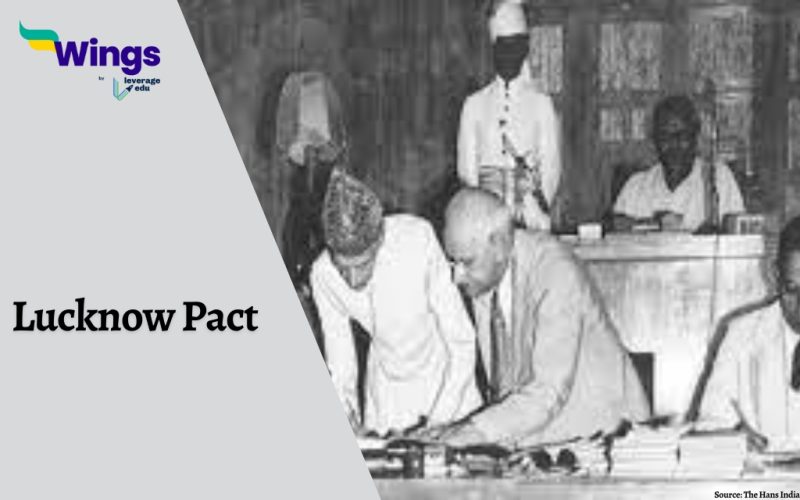The Lucknow Pact refers to an agreement that took place between the Indian National Congress (INC) and the All-India Muslim League. This joint session was held in 1916 in Lucknow. The pact was adopted by the Congress at its Lucknow session on December 29. On the other hand, the League adopted it on December 31, 1916. Interestingly, it is among the most important pacts in Indian history as it significantly enhanced the power of the All-India Muslim League in politics. Let’s discuss more details about the Lucknow Pact.
Table of Contents
Historical Background of the Lucknow Pact
There was a stark contrast between the ideologies of both INC and the Muslim League. While the former wanted to take India ahead as a whole, the latter was more focused
- The Muslim League was established in 1906.
- After the First World War, the Viceroy Lord Chelmsford asked for suggestions from Indians in return for their support of the British war effect.
- Muhammad Ali Jinnah who was leading the Muslim League at that time wanted to use this golden opportunity to introduce constitutional reforms through a joint Hindu-Muslim platform.
- Jinnah was an active member of both the parties and was also, significantly responsible for the introduction of the Pact.
- Interestingly, this was the first time that leaders from both parties agreed on a joint session.
- They agreed upon a bunch of major constitutional reforms.
- In 1916, 19 elected Indian members of the Imperial Legislative Council sought a memorandum to the Viceroy, seeking certain reforms.
- It was followed by leaders of both parties meeting in November 1916 in Calcutta.
- Lastly, the annual sessions took place at Lucknow in December 1916 and the INC and the League conformed to the agreement. This ultimately came to be known as the Lucknow Pact.
Also Read: Partition of India and Pakistan (1947)
Major Reforms Suggested in the Lucknow Pact
Below we have jotted down a bunch of major reforms as suggested in the Lucknow Pact.
- Self-government in India
- 1/3rd Muslim representation in Central Government
- Discontinuation of Indian funds to be used for the salaries of the Secretary of State for Indian Affairs.
- The abolition of the Indian Council
- Members of the Legislative Council elect their President themselves
- Increasing the term of the Legislative Council to 5 years
- Clear separation of powers of the executive branch from the judiciary
- Separate electorates for all communities
- Indians will represent at least half of the members of the Imperial Legislative Council
- Clear rules about the number of Muslims in the provincial legislatures
- Members to be elected on the basis of Universal Adult Franchise
- 4/5th of the members of the provincial legislature to be elected and 1/5th to be nominated.
Also Read: What was the 1st Amendment of the Indian Constitution?
Results of the Lucknow Pact
- The Lucknow Pact highlighted the underlying unity between the Hindu and Muslim communities.
- It brought the Muslim League into the limelight of Indian politics and gave it a stance against the Congress Party.
- It was only because of the Pact that the Indian National Congress finally saw the existence of Hindus and Muslims as two different communities.
What were the Issues with the Pact?
Although the Lucknow Pact offered numerous advantages,
- The approval of up to one-third representation of Muslims led to communal politics.
- It also started gradually losing mass support.
- The Pact made people realize that the interests of the Hindu community and Muslim community were entirely different.
Also Read: Widow Remarriage Act: Provisions, History
Relevant Blogs
| Charter Act of 1833 | Mountbatten Plan |
| Two Nation Theory | Vernacular Press Act of 1878 |
| Evolution of the Indian Flag | Role of Women in India’s Freedom Struggle |
FAQs
The Lucknow Pact of 1916 refers to a famous agreement between the Indian National Congress which was headed by Bal Gangadhar Tilak and the All-India Muslim League which was led by Muhammad Ali Jinnah. As the name suggests, it was adopted by the Congress during its Lucknow session on December 29 and by the League on December 31, 1916.
In the year 1916, Muhammad Ali Jinnah, a member of the Muslim League, negotiated with the Indian National Congress. The aim of these negotations was to pressure the British government to adopt a more liberal approach to Indian affairs and give Indians the sovereign authority to independently run their country.
The president of the Lunchnow session (1916) was Ambica Charan Mazumdar. Additionally, he also presided over the 1899 Bengal Provincial Conference at Burdwan.
That’s all about the Lucknow Pact. If you want to know more about topics like this, then visit our general knowledge page! Alternatively, you can also read our blog on general knowledge for competitive exams!
 One app for all your study abroad needs
One app for all your study abroad needs













